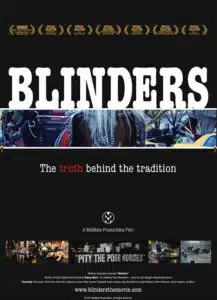
Peter Otero drives a carriage in Manhattan. As his horse, Junior, clops along in front of him, he looks back at the camera in his carriage and offers up some “history,” pointing out Strawberry Fields and other sights along his route. His customers appear happy with the ride, noting especially its likeness to “scenic” qualities and its “old movies.”
As Otero and the clients speak, the soundtrack in Blinders becomes almost unbearably clinky, so sweet and upbeat and faux-nostalgic that you’re about turn away after just two minutes of it. And then, a sharp turn in the story: the documentary reveals that it is not, in fact, about these seemingly charming experiences, but is instead focused on “another part of the business, which is working in the streets.” Subtitled “The Truth Behind the Tradition”, Donny Moss’ film goes on to lay out the New York industry’s many horrors and abuses, from the miserable lives of the horses to the corrupt and cruel practices of the drivers and owners.
Plainly a labor of love and outrage, the film is at once heartfelt and sensational, limited by a low budget and amateurish craft, but expansive in its legal and political charges as well as its emotional effects. Elizabeth Forel, of the Coalition to Ban Horse-Drawn Carriages, initiates the argument, remembering “a horse named Spotty” who was spooked by a noise as he worked (“It’s not unusual for horses to spook in the city,” she notes, as they are by nature prey animals and not predators, fearful and skittish and quick to bolt from danger).
Poor Spotty ran off, his carriage clattering behind him. A witness remembers, “This horse was really out of control,” as the story ends badly: Spotty and his carriage smashed into traffic and he had to be put down. The film cuts to a newspaper headline proclaiming the event and a candlelight vigil for Spotty, both leading to the decision by Forel and her cohorts that they needed to “go for a ban.”
Blinders goes on to present the pertinent issues, with intertitles posing categories from “Safety” to “Housing” to “Disposal” (“The horses are discarded like yesterday’s trash”), as well as pointed questions with obvious answers (“Is it humane?”). Chris Berry, of the Equine Protection Network, points out the problem with preserving the past in this instance: on “crowded, congested streets, it just looks like a time warp” to see horses struggling to make their way, their metal shoes clanking on pavement, a surface completely detrimental to the delicate balance of a horse’s physical structure.
The blinders most of the horses wear don’t quite save them from becoming afraid of sudden noises (horns, sirens, screeches, screams, jackhammers, crashes, barks) or movements (“Someone tossing a beer can nearby”). Not only that, Berry notes, the horses, being so fundamentally unable to cope, pose a risk to pedestrians or passengers in vehicles that might be hit by a flying carriage or 1,200-pound animal. Paramedic Danielle Cohen adds that the carriages, slow and unwieldy, impede ambulances’ progress in emergencies.
If the safety factors are not enough to convince you that the carriages are a bad idea, the documentary points out the mistreatment of the animals. Though paying customers might assume that the horses go home to fields of grass or large box stalls where they eat fresh green hay and loads of oats, the truth is, the animals are typically neglected, their injuries (sores, lameness, malnourishment) left untreated or poorly treated (horses are sometimes “underwatered on purpose,” reports an activist, so they will urinate less).
They live, more often than not, in standing stalls, on second or third stories in buildings with concrete floors, such that the horses never get a break from the hard surfaces that damage their hooves and legs. (In one notorious case, a stable caught fire, and 21 horses perished, as there was no legally mandated exit route from the upper floors.) The sad effects of close-ups of bloody wounds and emaciated ribs are compounded by shots of these stalls, where horses cannot lie down, cannot even turn around, but are instead forced to stand all night, heads hanging and eyes drooping.
If these images of distress and suffering remain mostly unseen (civilians are not allowed inside the stables), Forel recalls an incident involving a horse named Juliette (Forel names all the animals she cites, to reinforce the notion that they are individuals, with lives and feelings), who collapsed in central Park. Her driver beat her to get her to rise to her feet, creating a scene so disturbing that press gathered and a policeman passing by intervened by drawing his gun on the driver. “Juliette never did get up,” intones Forel, “It was a terrible image that went out into the world.”
Still, such public displays have not been enough to stop the practice. Though some efforts have been made to document abuses and present legal cases, these have been thwarted by political and financial interests. (Mayor Michael Bloomberg has called it a “great tourist industry,” adding, “People love the horses,” apparently unironically.) One clip has a documentary camera being assailed by a man in a face mask, yelling at the camera crew, “You got a fucking problem with the fucking horses? You pair of fucking wankers!” It’s a disturbing scene, even without a horse in sight.
Forel concludes, “What has to happen to make the city wake up is a death, unfortunately, the death of a person. Obviously, the death of a horse hasn’t done it.” It’s surely a grim thought, but as Blinders demonstrates, likely true.

